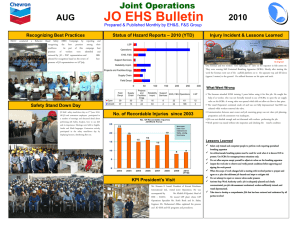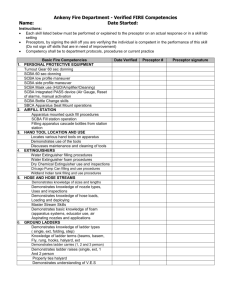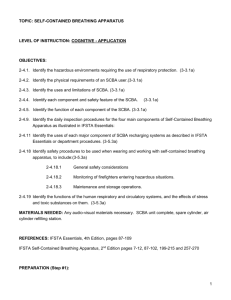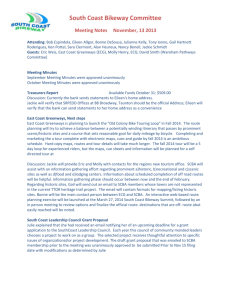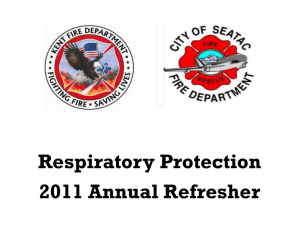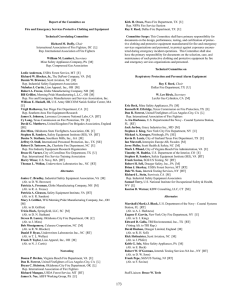issue: scba air cylinder handling - Ontario Association of Fire Chiefs
advertisement
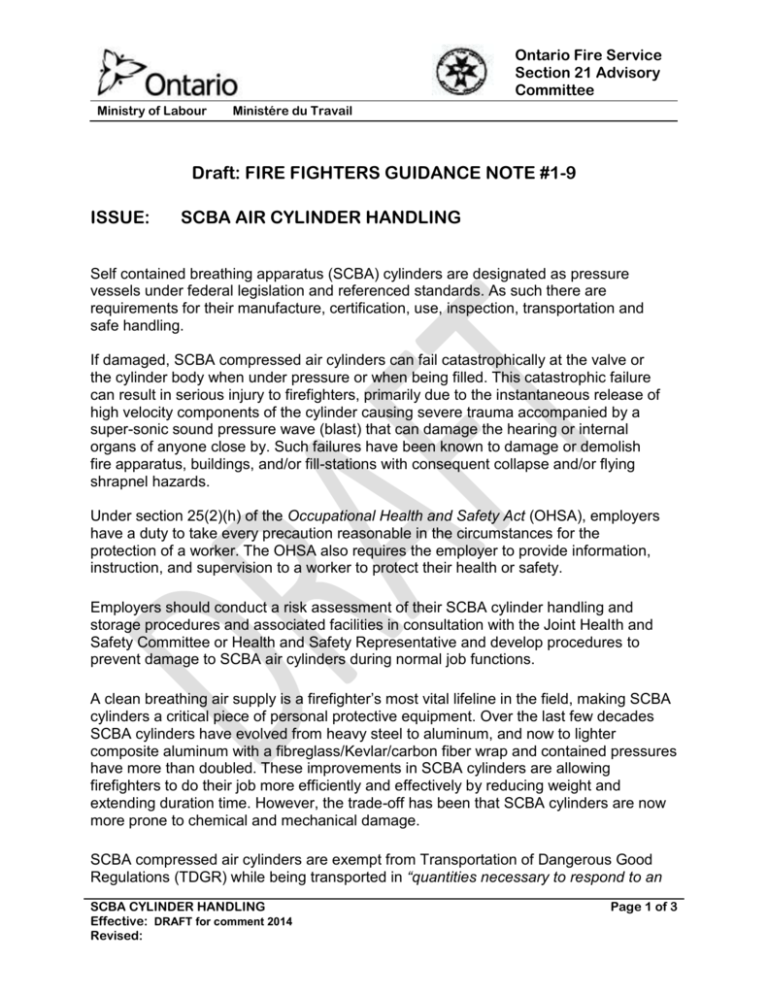
Ontario Fire Service Section 21 Advisory Committee Ministry of Labour Ministére du Travail Draft: FIRE FIGHTERS GUIDANCE NOTE #1-9 ISSUE: SCBA AIR CYLINDER HANDLING Self contained breathing apparatus (SCBA) cylinders are designated as pressure vessels under federal legislation and referenced standards. As such there are requirements for their manufacture, certification, use, inspection, transportation and safe handling. If damaged, SCBA compressed air cylinders can fail catastrophically at the valve or the cylinder body when under pressure or when being filled. This catastrophic failure can result in serious injury to firefighters, primarily due to the instantaneous release of high velocity components of the cylinder causing severe trauma accompanied by a super-sonic sound pressure wave (blast) that can damage the hearing or internal organs of anyone close by. Such failures have been known to damage or demolish fire apparatus, buildings, and/or fill-stations with consequent collapse and/or flying shrapnel hazards. Under section 25(2)(h) of the Occupational Health and Safety Act (OHSA), employers have a duty to take every precaution reasonable in the circumstances for the protection of a worker. The OHSA also requires the employer to provide information, instruction, and supervision to a worker to protect their health or safety. Employers should conduct a risk assessment of their SCBA cylinder handling and storage procedures and associated facilities in consultation with the Joint Health and Safety Committee or Health and Safety Representative and develop procedures to prevent damage to SCBA air cylinders during normal job functions. A clean breathing air supply is a firefighter’s most vital lifeline in the field, making SCBA cylinders a critical piece of personal protective equipment. Over the last few decades SCBA cylinders have evolved from heavy steel to aluminum, and now to lighter composite aluminum with a fibreglass/Kevlar/carbon fiber wrap and contained pressures have more than doubled. These improvements in SCBA cylinders are allowing firefighters to do their job more efficiently and effectively by reducing weight and extending duration time. However, the trade-off has been that SCBA cylinders are now more prone to chemical and mechanical damage. SCBA compressed air cylinders are exempt from Transportation of Dangerous Good Regulations (TDGR) while being transported in “quantities necessary to respond to an SCBA CYLINDER HANDLING Effective: DRAFT for comment 2014 Revised: Page 1 of 3 Ontario Fire Service Section 21 Advisory Committee Ministry of Labour Ministére du Travail emergency and that are in transport in a means of transport that is dedicated to emergency response.” However, SCBA cylinders will fall under the TDGR for all other circumstances including transportation on non-fire department vehicles, a nonemergency vehicle, or possibly while a fire truck is engaged in activities not associated with an emergency response. Specifically, the TDGR requires that SCBA cylinders be loaded, secured, and transported in such a way as to prevent, under normal conditions, damage that could result in an accidental release. Fire Departments should develop procedures, guidelines, work practices and facilities as follows; All SCBA cylinders whether empty or full should be secured during transport by means of a positive restraint that prevents cylinder chaffing, unwanted movement and damaging impact, or contact with chemicals. During storage (in the station or on fire apparatus) cylinders should be positively secured to prevent a fall to a hard surface or the potential for damaging contact with other equipment, apparatus doors, or contact with chemicals. At a fire scene full SCBA cylinders should be similarly protected against physical and chemical damage and generally kept as clean as possible. Certain chemicals that are common in the fire station are extremely corrosive to SCBA composite cylinder materials and can lead to catastrophic failure of the cylinder. Protection from chemical contamination should include proper handling and inspection as well as cleaning of cylinders after use. When a SCAB cylinder is stored and/or transported in any environment that could permit foreign contaminants such as dust, dirt, or chemicals to enter the open (hose) connection on the cylinder valve then a protective cap should be provided over the open connection to prevent contaminants from entering the open connection and potentially contaminating the air supply or damaging the SCBA regulator(s) possibly leading to a firefighter injury. Fill-stations for SCBA cylinders should be capable of containing a catastrophic failure during refill of the cylinder. Fill-stations should be used strictly in conformance with manufacturer’s instructions. Personnel working in the immediate vicinity of fill-stations should wear hearing protection with at least a 25 decibel noise reduction rating. Other personnel in the general area should also wear hearing protection but this could be of a lesser protection rating depending on their distance from the fill-station. SCBA CYLINDER HANDLING Effective: DRAFT for comment 2014 Revised: Page 2 of 3 Ontario Fire Service Section 21 Advisory Committee Ministry of Labour Ministére du Travail SCBA cylinders should be visually inspected before filling and after every use to determine if there is visible damage to the bottle and/or valve assembly. Any damage noted that exceeds the manufacturers recommendations as acceptable should be immediately removed from service and sent to formal inspection and testing by a qualified agency. References: Occupational Health and Safety Act (OHSA) Clause 25(2)(a) and (h) CAN/CSA B340 - Selection and Use of Cylinders, Spheres, Tubes, and Other Containers for the Transportation of Dangerous Goods, Class 2 Transportation of Dangerous Goods Act, 1992 (1992, c. 34) and Regulations as amended. Particularly Sections 1.26, 5.1, 5.4, SCBA CYLINDER HANDLING Effective: DRAFT for comment 2014 Revised: Page 3 of 3


